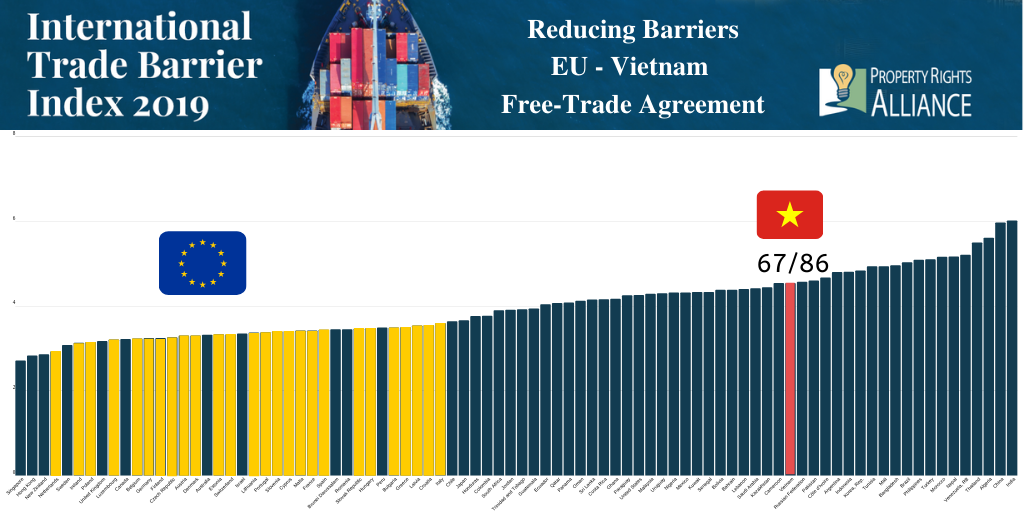EU-Vietnam Free Trade Agreement: Increasing Economic Opportunity By Reducing Trade Barriers
On June 8 Vietnam’s National Assembly ratified theEU-Vietnam Free Trade Agreement (EVFTA) and theEU-Vietnam Investment Protection Agreement (EVIPA) which will take effect in July or August. This agreement will cut or eliminate almost 99 percent of tariffs and customs duties on goods traded between the two parties.
Currently, the EU imports $38 billion of goods from Vietnam and imposes an applied tariff rate of 5.2%. Vietnam imports $12.5 billion from the EU and imposes a 9.5 percent applied tariff rate. The two are an excellent pair for a bilateral agreement, as the EU is able to grant access to a much larger market in exchange for Vietnam adopting market reforms, including reducing its much more restrictive trade barriers.
The two are on opposite spectrums of the Trade Barrier Index. The 28 EU members are all found in the first 37 spots of the Index, while Vietnam, a communist country with a history of import substitution places 67th for its excessive tariffs and services restrictions that limit FDI.

With unanimous approval of over 94 percent in favor of the EVFTA and over 95 percent supporting the EVIPA, lawmakers hope these agreements will give Vietnam’s economy a vital boost as it looks to recoup from the effects of the COVID-19 pandemic.
Nicolas Auidier, chairman of EuroCham, mentioned the importance of the EVFTA in such a pressing time with a global pandemic disrupting global business operations, saying “free, fair and rules-based trade is the best roadmap to economic growth.” With this FTA, Vietnam can now enter a EU consumer market of around 500 million people who are eager to invest in key Vietnamese industries.
With Vietnam already taking steps to reduce trade barriers in the country through their membership in the Comprehensive and Progressive Agreement for Trans-Pacific Partnership (CPTPP). An FTA with the EU will help Vietnam continue to eliminate trade barriers and promote economic growth, as the EU is a key market for Vietnam’s exports and one of their biggest investors.
After the U.S., Vietnam was the EU’s second-largest export market with a market value of upward $41 billion USD. With the EU already active in more than 18 economic sectors and 52 provinces in Vietnam, the agreement will eliminate previous barriers to trade and get rid of tariffs in key export industries.
Some of the largest industries impacted by the agreement are labor and manufacturing heavy such as textiles, electronics, pharmaceuticals, and agriculture. This FTA will exponentially raise Vietnam’s export amount to the EU and will expand the capital margin and productivity in these industries.
Although the National Assembly passed the EVFTA agreement in full terms, implementation will require modifications to existing law and acceding to international agreements. For instance, Vietnam is required to accede to the WIPO Copyright Treaty and WIPO Performances and Phonogram Treaty.
Reducing trade barriers allows economies to compete in the areas where they have a unique comparative advantage. The World Bank, estimates that by 2030 the EVFTA will increase Vietnam’s GDP by 2.4 percent and exports by 12 percent. The European Commission has also predicted an increase of the EU’s overall GDP by $29.5 USD billion by 2035.
With the ratification of EVFTA, Vietnam hopes to bring in investors from Europe and around the world. In a time where COVID-19 has devastated economic activity worldwide, a free trade agreement will help foster economic growth in both the EU and Vietnam, allowing key industries to flourish, directly benefiting consumers.
Photo Credits: Noah Windler

